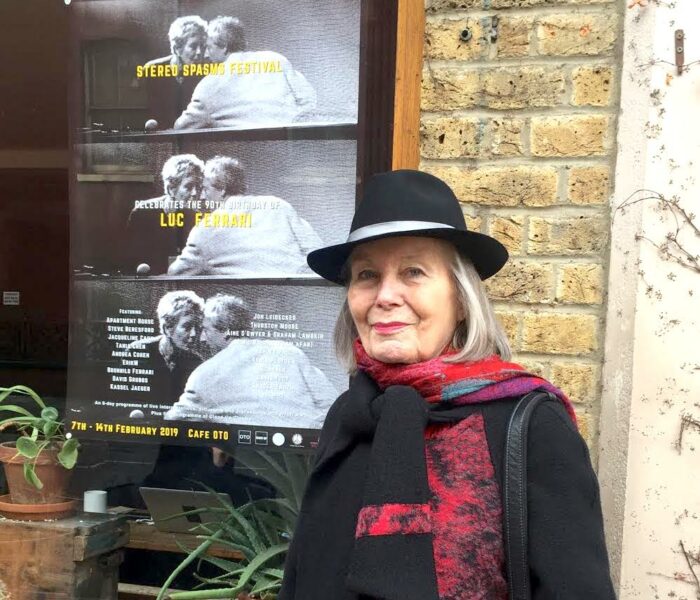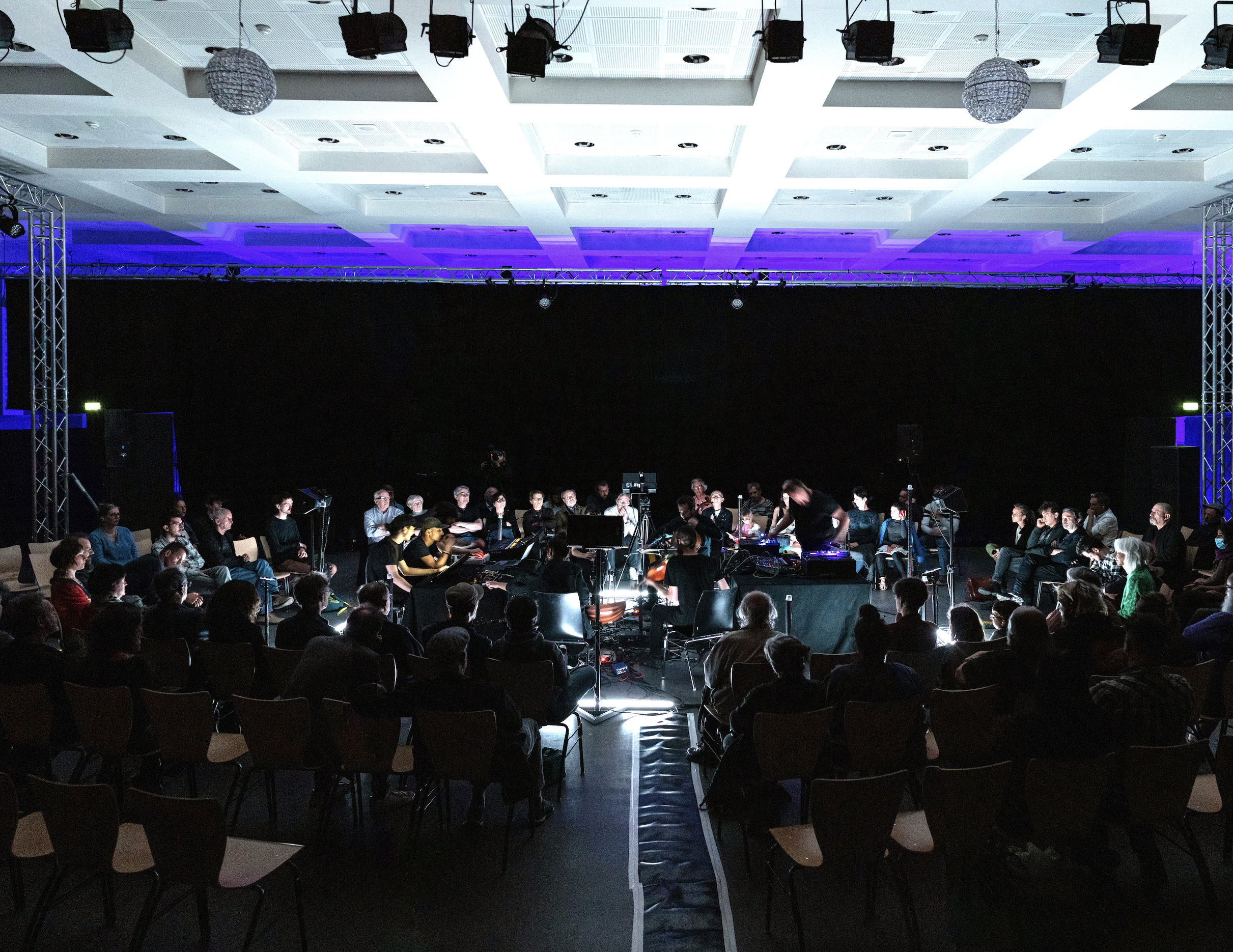Sculptrice de formation, Méryll Ampe a transposé dans le domaine du son ses recherches sur la matière et la forme en partant d’enregistrements issus de son environnement immédiat. Et en tirant parti des potentialités vibratoires du son pour mieux, notamment lors de ses performances live, sculpter l’espace.
A l’origine, Méryll Ampe (née en 1984) était sculptrice sur bois. A sa sortie de l’école Boulle, elle s’est dirigée vers l’Ecole des beaux-arts de Cergy, réputée pour l’importance qu’y occupe l’art sonore. Si son travail plastique parle de son sans jamais rien donner à entendre, le travail sonore qu’elle a développé là-bas parle de sculpture de manière immatérielle. Cette activité « musicale », qui occupe aujourd’hui la majeure partie de sa vie d’artiste, s’est développée en premier lieu avec un enregistreur Zoom et un micro – et puis bien sûr des bons logiciels : le field recording en a toujours été la matière originelle, première. Sommairement traités, les sons du réel ont forgé la grammaire d’une musique nourrie (« informée ») par les grandes œuvres de la musique concrète.
Cette approche sculpturale du son se double également d’un travail sur sa force vibratoire, sa puissance physique, sa projection dans l’espace : « Je cherche à amplifier les vibrations pour jouer de manière physique, c’est-à-dire que le corps soit impacté par l’état vibratoire de l’espace. Ces états vibratoires provoquent des images, des émotions, des ressentis abstraits. Le son peut projeter vers l’avant comme un mouvement énergétique, vital… », expliquait-elle récemment à l’artiste Lauren Tortil pour sa série [woːks] – série de rencontres en ligne et en musique autour de l’art sonore. La sculpture elle aussi engage le corps, après tout. Ainsi les performances lives représentent-elles une part essentielle de sa pratique, de cette musique à la fois horizontale et verticale, méditative et cathartique, intérieure et physique. C’est que Méryll Ampe, si elle aime à citer Luc Ferrari et William Basinski, a écouté beaucoup de « rock » (Led Zeppelin aussi bien que Durutti Column, Silver Apples ou Bauhaus) avant que la techno (Plastikman, Peaches, Mika Vaino, Pantha du Prince) et la fréquentation des clubs ne viennent déclencher son envie d’en faire : « D’ailleurs, le rythme revient dans ma musique, ces jours-ci », constate-t-elle. Et l’on ne s’étonne guère qu’elle ait fait de la lucha libre, cette variante mexicaine du catch, spectaculaire au point de bouleverser tous les sens, la matière de son projet le plus ambitieux jusqu’à présent : une installation sonore dans laquelle le documentaire, le réel lui-même deviendrait une matière à manier et à pétrir, cinéma pour l’oreille qui entraîne l’auditeur, nous dit-elle, dans un trip « subjectif, lyrique »…
Si vous avez appris le violoncelle et la batterie à l’adolescence, c’est aux beaux-arts de Cergy que vous avez basculé vers l’informatique et l’électronique musicales. Est-ce à cette période que vous avez découvert le field recording ?
Oui. Mes professeurs – mon professeur au conservatoire et mon professeur d’art sonore à Cergy –nous avaient donné un micro et un enregistreur, au moyen desquels on devait proposer une pièce. C’était surtout des bruits urbains. J’ai l’impression que le field recording a été le vecteur qui m’a vraiment amenée à être davantage dans la musique. C’est cette pratique, en me permettant de réunir la matière de la vie de tous les jours – que ce soit ma batterie ou la chaufferie de chez mes parents – et de composer à partir de ça, qui m’a amenée à l’électroacoustique. Si j’avais pu entendre des pièces de Denis Dufour et de Pierre Henry, je ne connaissais pas du tout ce genre de musique avant d’arriver à Cergy. Mon objectif initial était de combiner sculpture et son. Et puis en fin de compte, au bout de deux ans, j’ai basculé totalement dans l’immatérialité.
Avez-vous des sources sonores ou un matériel d’enregistrement de prédilection ?
J’avoue avoir longtemps eu un faible pour toutes les machines industrielles. Mais c’est vrai que quand j’étais étudiante, n’ayant pas forcément beaucoup d’argent, j’ai commencé avec les choses qui étaient dans ma chambre, autour de moi. Ça peut aller dans le microscopique aussi bien que dans le macro – je peux par exemple enregistrer un gros coquillage dans ma salle de bain ou dans ma baignoire – et ça s’étale dans le temps : je teste des choses, comme si l’objet que je bougeais devenait un instrument. Peut-être qu’on perd un peu la notion de « terrain » inhérente au field recording, parce que je me mets en situation dans mon espace quotidien, j’utilise des objets qui se trouvent autour de moi… Plus tard, je suis allée enregistrer des choses comme l’ambiance de la nuit dans la forêt, un peu à la Luc Ferrari, que j’adore. Mais ça reste des choses simples.
De même, n’ayant pas de super micros, c’était principalement de la stéréo, avec un amplificateur ou avec un enregistreur Zoom : le Zoom permet de dégainer très rapidement, quitte à avoir un peu de parasites ou des sautes de dynamiques quand on bouge – des espèces de tension étranges avec le grain, des accidents qui produisent parfois des choses intéressantes… Pour moi, le field recording est lié à l’attente : j’enregistre pendant 15 minutes et j’essaie ensuite de trouver la perle rare dans ces 15 minutes.
Jusqu’à ce que vous ajoutiez le synthétiseur, le field recording a donc été le matériau principal, la base de votre travail sonore…
Totalement. La matière première, c’était vraiment des sons concrets, des matières quotidiennes, parfois très brutes, traitées de manière vraiment simple : rajouter du gain, peut-être un peu d’overdrive, équalizer… Je procède plutôt par superpositions, par strates. Plus tard, quand j’ai fini par acheter mon premier petit synthé, je me suis intéressée à l’énergie électronique. Mais je reviens toujours aux field recordings, je les réinjecte régulièrement dans ma musique, parfois comme des souvenirs, des éléments d’ordre presque psychoacoustique… En revanche, c’est sûr que je ne fais pas du tout le même travail que Chris Watson, Thomas Tilly ou Julie Rousse, par exemple.
Votre travail sonore a longtemps été conçu pour le live plus que pour le disque ou l’enregistrement…
C’est vrai que mes recherches, que ce soit sur le terrain ou en studio, sont souvent d’abord pensées pour le live. Même si je travaille de plus en plus avec des cinéastes ou des chorégraphes, donc sur des compositions fixes. J’utilise en revanche très peu de son dans mon travail plastique, « physique » : ça parle plutôt du volume du son, du silence, de la manière dont on voit le son en relief, mais sans le faire intervenir.
La physicalité du son est-elle quelque chose d’essentiel à vos yeux ?
Clairement. C’est vrai que je perçois d’abord le médium sonore en termes de densité, de masse. Ce que je cherche à plus à voir avec des choses physiques, matérielles, c’est un rapport aux vibrations, à l’énergie, aux perspectives, aux dynamiques, à l’horizontalité et la verticalité qui ramène pour moi à la sculpture. J’y vois une analogie avec ce que j’ai pu faire auparavant en tant que sculpteure sur bois – ma première formation… De même, en tant que performeuse, je conçois la plupart de mes concerts en fonction du lieu qui les accueille, du système sonore, de l’impression acoustique. J’aime jouer avec des choses qui sont parfois assez massives, donc j’ai besoin de connaître un peu le lieu, la manière dont l’espace résonne et répond, pour savoir quel outil utiliser pour les mettre en relief, jouer sur certaines profondeurs, sculpter, tailler un peu plus le son, le modeler en direct. Là où certains parleraient de fréquence, de timbre, de tessiture, je vois plutôt des volumes, des formes, des états, différents moments…
L’opposition entre la figuration (ou le naturalisme) et l’abstraction (puisque les field recordings ne vous intéressent pas pour ce qu’ils représentent, vous les déformez jusqu’à les rendre méconnaissables) est une autre tension fertile à l’œuvre dans votre travail. A cet égard, votre installation Lucha libre tranche un peu par son côté presque documentaire…
C’est vrai que lorsque j’ai découvert la lucha libre (la « lutte libre », variante mexicaine du catch, Ndlr.) au Mexique, j’ai été impressionnée, plongée dans un truc que je ne connaissais pas, ça m’a donné plein d’envies, et j’ai immédiatement eu envie de revenir capter ces sons. Après un très gros travail de field recording sur place, au Mexique, Lucha libre a donné lieu a deux volets, deux formats qui ne parlent pas de la même chose. Il y a eu d’abord une pièce radiophonique de cinquante minutes, à laquelle j’ai commencé à travailler début 2018, peu après mon retour du Mexique : c’est une sorte de journal audio, avec une dimension très intime (je raconte un peu ma vie, je parle du tremblement de terre, de mes doutes, j’essaie d’injecter du quotidien personnel). L’installation, elle, qui a nécessité un énorme travail de production sur plusieurs années, part du monde connu pour aller dans un autre monde, vers quelque chose d’abstrait, de bruyant. La composition dure 24 minutes, on part d’un moment de la vie de tous les jours et petit à petit, ça switche vers un univers imaginaire, même s’il est parfois référencé (certains sons peuvent par exemple évoquer les jeux vidéo) et même s’il y a toujours des moments où le réel revient, y compris vers la fin, où on commence à ne plus savoir où on est… Il n’y a aucune image, juste de la lumière, du son et de la fumée, et le son prend du coup un corps hyper important : c’est un jeu presque cinématographique pour embarquer le public ailleurs, vers quelque chose de totalement subjectif, lyrique, où chacun peut voir ce qu’il veut. C’est vraiment un trip.
Quelle place tient aujourd’hui la sculpture dans votre pratique ? Qu’est-ce qui vous décide à produire une sculpture plutôt que du son ?
En ce moment, je suis très happée par le son, la composition, les lives, les recherches avec mes machines, les « commandes » pour le spectacle vivant ou pour le cinéma. Je fais beaucoup moins de pièces sur une matière ou un support parce que j’en ai beaucoup moins le temps. Mais il m’arrive qu’à l’occasion d’expositions collectives, on me demande de produire quelque chose, une sorte de mini-édition – un dessin par exemple – toujours autour du son. Je dois participer prochainement à une expo collective à l’atelier W, à Pantin, sur le thème de l’escalier, et je suis en train de réfléchir à ce que je vais produire… Je suis également en résidence à la Station, à Aubervilliers, où je travaille à une installation sonore autour de la cabane : je vais construire une cabane – une vraie cabane faite de branches et de rondins, comme en forêt – dans laquelle se trouvera un mini-studio où on pourra composer.
Cela dit, mon travail sonore englobe toujours une dimension graphique. Dès que j’ai un nouveau projet, je fais des notations, je dessine, je réalise des partitions avec de la couleur, des stylos, des feutres, pour voir l’énergie que je veux transmettre dans la composition. J’ai toujours des carnets, des feuilles A3, pour pouvoir y revenir, et aussi pour pouvoir expliquer mes projets à des gens.
David Sanson
*En concert à Paris le 14/10 (en duo avec Elizabeth Saint-Jalmes), le 23/10 (trio Be My Ghost) et le 19/11, à Bruxelles le 18/11 et à Lyon le 21/11.



)



